SAN SEBASTIÁN, BASQUE COUNTRY, SPAIN - Mornings don’t get much better than in this Bay of Biscay beauty that snuggles up against Europe’s southwest coast just south of France. That’s because the days here usually begin with the sun casting a glorious painter’s light on San Sebastián’s picturesque Bahía de la Concha, the iconic circular bay featuring a magnificent beach — Playa de la Concha — that wraps around the tranquil cove like a golden ribbon.
As I pull back the curtains of my Hotel Londres window — the legendary property sits on the shores of Bahía de la Concha like a giant white sand castle — I see the morning begin to unfold in a city the Basque call Donostia.
To my surprise, I see a group of young surfers straddling their colourful boards in the bay while patiently waiting for a wave to rumble in off the Bay of Biscay so they can “Hang Ten” in this surfer’s paradise. Who knew San Sebastián is the surfing capital in this part of the world? In fact, it has three beaches where waves — reportedly some of the strongest in the world — provide surfers with lots of thrill rides.

Above: San Sebastián is the Hawaii of Europe and offers some of the best surfing anywhere.
Off in the distance I see a small fleet of Basque fishing boats leave a foamy trail as they head out to sea from the city’s ancient port. En route they pass Isla de Santa Clara, the city’s fairytale island that juts out of the water near the entrance to the Bay of Biscay. It’s treasured here for its beach and historic lighthouse.
Below my window local joggers and dog walkers are leaving their footprints in the beach’s hard-packed sand — they’re up early on this mid-September morning hoping to avoid the hordes of tourists in town for San Sebastián’s world-famous film festival.
As I look out towards the city’s Old Town (Parte Vieja), I’m impressed with the red tiled roof skyline and the collection of Baroque and Gothic-style buildings gathered there. The long (six-kilometre) promenade — Paseo Nuevo — that wraps around Monte Urgull, a turtle-shaped mountain topped with a fort that has guarded the Old Town since it was established, looks inviting.
The smell of freshly roasted coffee wafting up from the seaside cafés below my window tells me it’s time to start exploring this Basque playground with the French Rivera good looks.
As I leave the Hotel Londres en route to the Old Town, I’m met by a small group of autograph seekers. Many Hollywood types stay at either this posh property and the elegant Maria Cristina Hotel nearby when they are in town for the annual San Sebastián Film Festival, which, along with the city’s equally prestigious Jazz Festival, have helped make this the glamour and cultural capital of the Basque country. In fact, in 2016 San Sebastián was recognized by the European Union as the Cultural Capital of Europe.
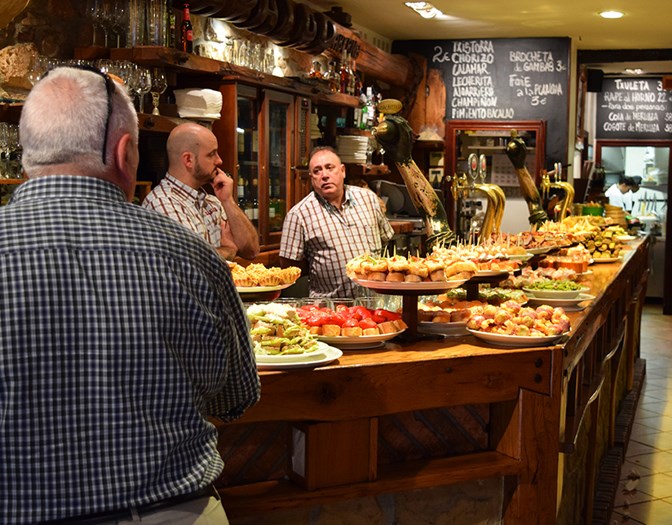
Above: San Sebastián is famous for tapas-style food called pintxo which is served everywhere.
The first building I encounter is City Hall, a palace-like structure that once served as a casino during San Sebastián’s Belle Epoque period.
Looking down one of the narrow streets in the Old Town, I see the famed Basilica de Santa María del Coro, an 18th-century church that stands at the foot of Monte Urgull, the mountain that is crowned with a revered statue of the Sacred Heart.
The basilica is one of the most visited tourist attractions in San Sebastián and features an impressive Churrigueresco facade and a statue of Saint Sebastián in its niche. It was built over a Roman temple and is an architectural wonder — a rectangular plan with a semicircular apse. Inside, its neo-Gothic vaulting and pillars are what impress most.
It’s in front of the church where I meet David Elexgaray, a Basque man who was born in England to a Basque mother and father, and who later moved to a small town outside Bilbao, an hour’s drive away. David has agreed to show me around the Old Town and describes San Sebastián as the “15-Minute City” because everything here “is within a 15-minute walk.”
As we start out on our walking tour, David tells me Basque people are fanatics about food quality and freshness. “That’s why visitors should always look for the “K” (it stands for quality) symbol on food sold in stores or markets, or the “0 km” logo (it indicates farm to table freshness and guarantees locally grown ingredients) at the entrance of restaurants and bars.”
As we pass an open door with the word pribatua (private) attached to a sign, David reveals this to be one of the city’s famed txoko — private gastronomy clubs that until recently were for men only. Members invite their families and friends to the restaurant-style clubs where the host displays his culinary talents for all to enjoy.
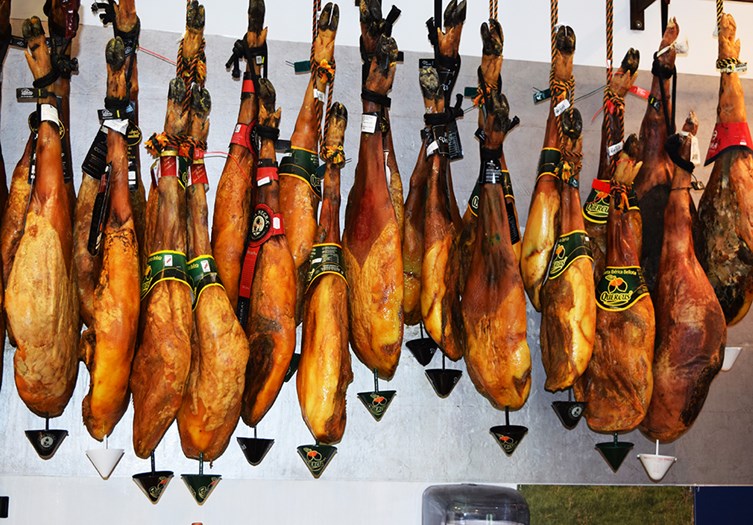
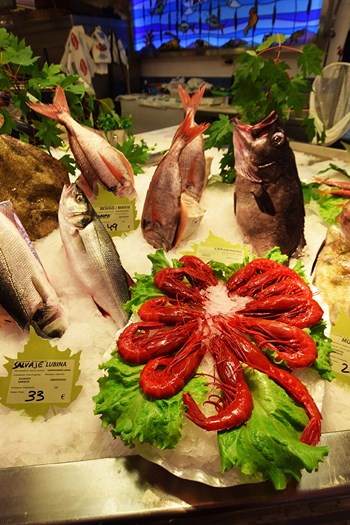
Above: Food is an important part of the Basque culture and ham and fish top the list.
“In recent years, some female txokos have opened as well but they are still mainly a male domain and you must be invited to visit one,” David tells me.
To show just how high a priority food is in the Basque country, David informs me that the autonomous region of just 2.5 million people boasts the highest concentration of Michelin-star restaurants in the world. And San Sebastián is home to seven of the most famous Michelin star rooms, which between them have 15 stars. Two of them, Mugaritz and Arzak, are also ranked among the world’s 50 Best Restaurants.
However, the real culinary treat in San Sebastián is the affordable pintxo (pronounced pincho) — the Basque version of tapas, only much better. The bite-sized treats — usually bread or eggs stuffed with some incredible toppings — are the national dish of the Basque country and a staple in almost all bars. The first ones actually appeared in San Sebastián’s tiny Old Town, which just happens to boast the highest concentration of bars in the world.
The bars we pass have their bar tops lined with dozens of plates piled high with the Basque hors d’oeuvre in anticipation of the lunchtime crowd — lunch in this part of the world starts around 2 p.m., while dinner usually begins after 9:30 p.m.
“Each bar has their own special pintxo,” David tells me as I gobble down the most famous of the bite-sized snacks — the Gilda, created to honour Rita Hayward’s role in the movie Gilda. Peppers, olives and anchovies are skewered together to make the Gilda. “The ingredients are hot, saucy and spicy, just like the Gilda character in the movie,” smiles David.
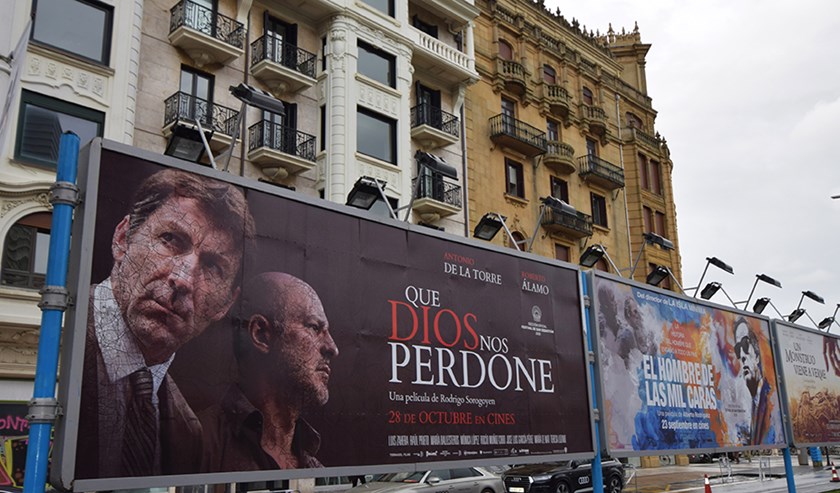
Above: San Sebastián's annual movie festival ranks right up their with Cannes in terms of importance.
As we make our way to San Sebastián’s fish market, we pass Plaza de la Constitución (Constitution Square), a small plaza filled with handsome apartments featuring narrow doors and intricate wrought iron balconies. Above each of the shuttered doors is a number.
“Do you know what the numbers represent?” asks David.
The logical answer would be an address but David reveals the numbers were actually used to identify where spectators would stand when the square was used for bull fights.
Before leaving the Plaza de la Constitución, where many of the city’s largest festivals are held annually, David cautions: “Avoid the restaurants and bars in this plaza because they are the most expensive in the city.”
A few minutes later we enter the main food market in San Sebastián, Mercado de la Bretxa (Bretxa Market), where fish mongers painstakingly arrange their freshly-caught products (usually from the Bay of Biscay) in artful displays that truly are remarkable. This may be the cleanest food market in the world — “the people take great pride in this market and, again, freshness and quality are high priorities here,” says David.
Fish here are fresh and their eyes clear — I think one of them winked at me.
Also on display in the market is Jamón Ibérico, the famous Iberian ham made from black pigs. The hams, which look like giant clubs, hang in the market’s butcher shops with tiny cups attached at the bottom.
“The cups catch the fat that runs off during the aging period,” says David, who adds the hams are cured in the mountains (“in open windows so the air circulates around them”) between four and five years before they are sold. What makes the hams taste so special is the pig’s diet — acorns.
At a nearby ham shop, a woman using a long razor-sharp knife carves me a paper thin slice of the marbled meat and it instantly melts on my tongue like butter.
When we reach the banks of the River Urumea, which flows into the Bay of Biscay, I’m impressed with the futuristic glass building standing on the opposite side of the ornate María Cristina Bridge.
“That’s our Kursaal Congress Centre and Auditorium and it’s the headquarters of the San Sebastián Film Festival and where many of the movies are shown,” says David of the stylish building designed by famed Spanish architect Rafael Moneo.
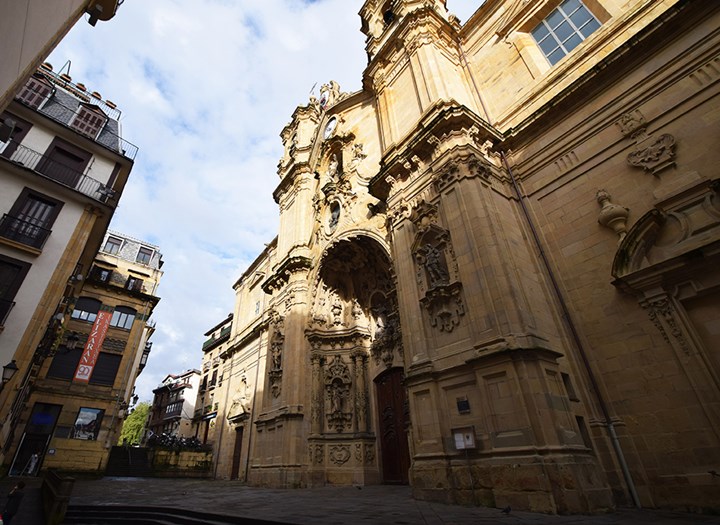
Above: The Old Town of San Sebastián features some lovely Basilica de Santa María del Coro.
“The Kursaal opened in 1999 and this year (2016) over 600,000 people have visited it,” says David, who adds, “the Kursaal is especially stunning at night when it’s all lit up.”
Some of the most famous actors in the world have walked on the red carpet spread out in front of the Kursaal because the San Sebastián Film Festival, which started in 1953, is regarded as one of the most important in the industry.
Behind the Kursaal are two more surfing beaches — Ondarreta and Zurriola — and the water is full of boarders waiting for the next wave to roll in from the Bay of Biscay. David says the waves here favour left-handed surfers and that’s why so many participants come from around the world to surf here.
We return to the Old Town via the Paseo Nuevo promenade and as the old port comes into view, David points out a red-brick palace (Palacio de Miramar) off in the distance that’s perched overlooking the Bahía de la Concha and the seaside brilliance.
“Donostia (San Sebastián) once served as the summer residence for Spain’s royal family,” David tells me. “Queen Maria Cristina established the summer palace here in the 19th century.”
A cluster of hotels and apartments stands along the shores of the Bahía de la Concha, including my Hotel Londres, and David says real estate in San Sebastián is the most expensive in all of Spain.
The city also boasts an excellent aquarium and a world-renowned spa — La Perla, which is within walking distance of the Hotel Londres. The Perla’s seaside restaurant is also one of the best in San Sebastián.
The promenade drifts off into the old port area from where Basque fishing boats have been heading out to sea for centuries. The small fish restaurants located in the port area are some of the best and cheapest in the city.
We reach Hotel Londres just as the setting sun casts fiery hues of red and orange on the surface of the Bahía de la Concha, creating yet another memorable moment for me in San Sebastián.
Information
The Best way to get to San Sebastián from Canada is via London or Paris. Air Canada, British Airways and Air France have daily flights to Europe. / Hotel Londres is located in walking distance of the Old Town and offers one of the most breathtaking Bay of Biscayne views you can imagine. Room rates start around $125 Cdn a night. Fr informstion, go to https://www.hlondres.com/en/ For more on the Basque country, go to
www.basquecountrytourism.eus